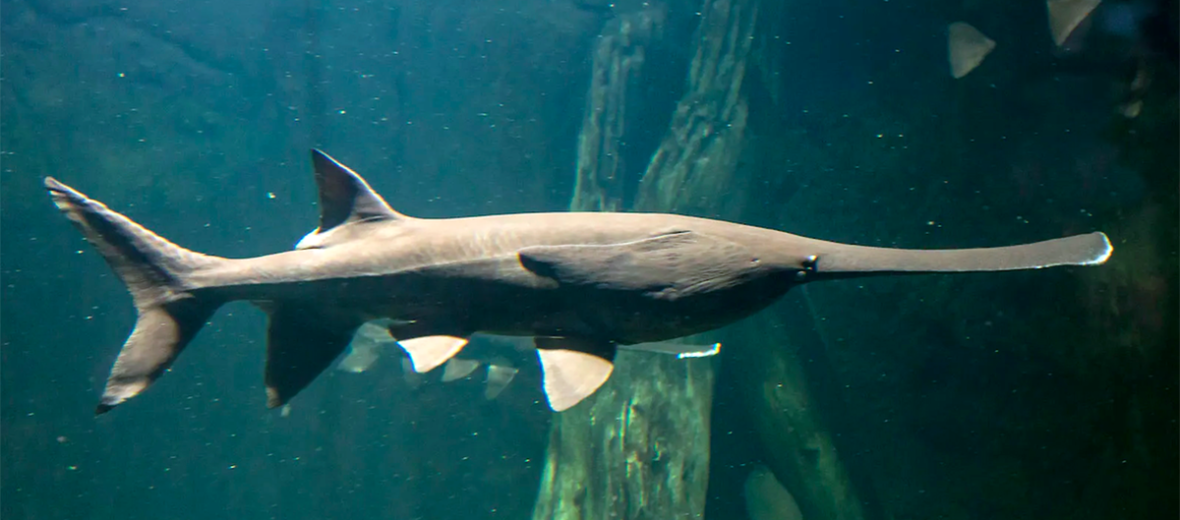
The American paddlefish, aka Mississippi paddlefish, spoonbill, or spoon-billed cat, is a smooth-skinned, ray-finned fish. They are closely related to the sturgeon. Paddlefish fossil records date back to approximately 125 million years, to the Early Cretaceous. Due to the threats of habitat destruction, at the hands of residential and commercial development, mining, agriculture, dams, and water management projects; shipping lanes disturbing their habitat; pollution; recreational activities; overfishing; climate change; and invasive species (and with them disease and out competing for food), these fish are listed as Vulnerable by the IUCN. The Texas Gulf populations are listed as Endangered.
First the Stats…
Scientific name: Polyodon spathula
Weight: Up to 60+ lbs.
Length: Up to 4.9 feet
Lifespan: Up to 30+ years
Now on to the Facts!
1.) They have an almost entirely cartilaginous skeleton and are equipped with a paddle-shaped rostrum (nose or snout) that measures up to 1/3 of their body length.
2.) These fish are sometimes referred to as a freshwater sharks, due to their dorsal fin and caudal fin (tail) shape.
3.) American paddlefishes have evolved the ability to filter feed.
4.) Their rostrum has thousands of tiny sensory receptors that are used to detect zooplankton swarms. This is similar to the ampullae of Lorenzini in sharks.
5.) Overfishing continues to be a contributing factor in their decline, due to the demand for caviar.
But wait, there’s more on the American paddlefish!
6.) These fish are born without a rostrum. It begins to develop shortly after hatching and grows as they age.
7.) They feed via the ram suspension-feeding method. This is where they swim forward continuously with their mouth open wide, forcing water over their gill rakers to filter out prey.
Did you know…?
American paddlefish are typically referred to as primitive fish, or a relict species, because of their morphological characteristics which they retain from some of their early fossilized ancestors.
8.) The electroreceptors in their rostrum may also act as an obstacle avoidance system.
9.) Unlike most other fishes, American paddlefish barely respond at all to overhead shadows or changes in lighting.
10.) Due to their electroreception they don’t much rely on their otherwise poor vision.
But wait, there’s still more on the American paddlefish!
11.) Besides the electroreceptors located on their rostrum, they have sensory pores covering nearly half of the surface of their skin, extending from the rostrum to the top of their head, down to the tips of their operculum (gill) flaps.
12.) The female will not begin spawning till she reaches 7 – 10 years of age. Some wait till they reach upwards of 18 years old.
Did you know…?
Females can produce between 70,000 – 300,000 eggs each spawning season. The larger egg productions are typically only seen in captive breeding programs, designed to propagate the species.
13.) Their spawning migration upstream takes place between early spring to late fall.
14.) Spawning is triggered by 3 events: water temperatures of 55° – 60°F; a lengthened photoperiod – brought on by the longer daylight availability of spring; and the proper rise and flow in the river. Due to their requirement of these 3 conditions, mating can sometimes take place every 4 – 5 years.
15.) These fish are broadcast spawners, aka mass spawners or synchronous spawners. This is where the female will release her eggs over bare rocks, sand, or gravel and then the males will release their sperm over the eggs.
But wait, there’s still a bit more on the American paddlefish!
16.) Based on the temperature of the water, the inseminated eggs will hatch in up to 7+ days.
17.) After hatching, the larval fish will drift downstream to areas of lower river flow, where they begin foraging on zooplankton.
18.) Due to the poor swimming capabilities of the fry, they are significantly subjected to predation. Hence they grow at a whopping 1 inch per week. Their growth though is dependent upon available food, of course.
19.) Once they reach about 12 inches long, their growth rate slows significantly to about 2 inches per year, based again upon available food.
20.) In 2020 it was reported that eggs from 3 Russian sturgeons were crossbred with American paddlefish using sperm from 4 male paddlefish. This resulted in hybrids called sturddlefish. This was the first time that fish from different families were successfully bred.
But wait, there’s still a little bit more on the American paddlefish!
21.) Sturddlefish have up to a 74% survival rate and reach upwards of 2.2 lbs. by 1 year of age.
22.) American paddlefish are a popular sport fish, and hatcheries exist to repopulate and restock various areas in order to sustain the sport fishing hobby.
23.) Zebra mussel infestations have taken a toll on American paddlefish populations by out-competing them for zooplankton. These mussels are an invasive species in many bodies of water throughout North America. Be sure to thoroughly clean your boat, after leaving any body of water to help thwart the spread of these mussels.
24.) Another deficit these fish face is the fact that the roe of American paddlefish can be processed into caviar that is similar in color, taste, size, and texture to Sevruga sturgeon caviar, found in the Caspian Sea. This puts a huge dent in their populations.
25.) Their only predators are larger fish, while the paddlefish are younger, American alligators, and humans when older.
Now a Short American paddlefish Video!
Be sure to share & comment below! Also, check out the Critter Science YouTube channel. Videos added regularly!
Want to suggest a critter for me to write about? Let me know here.



